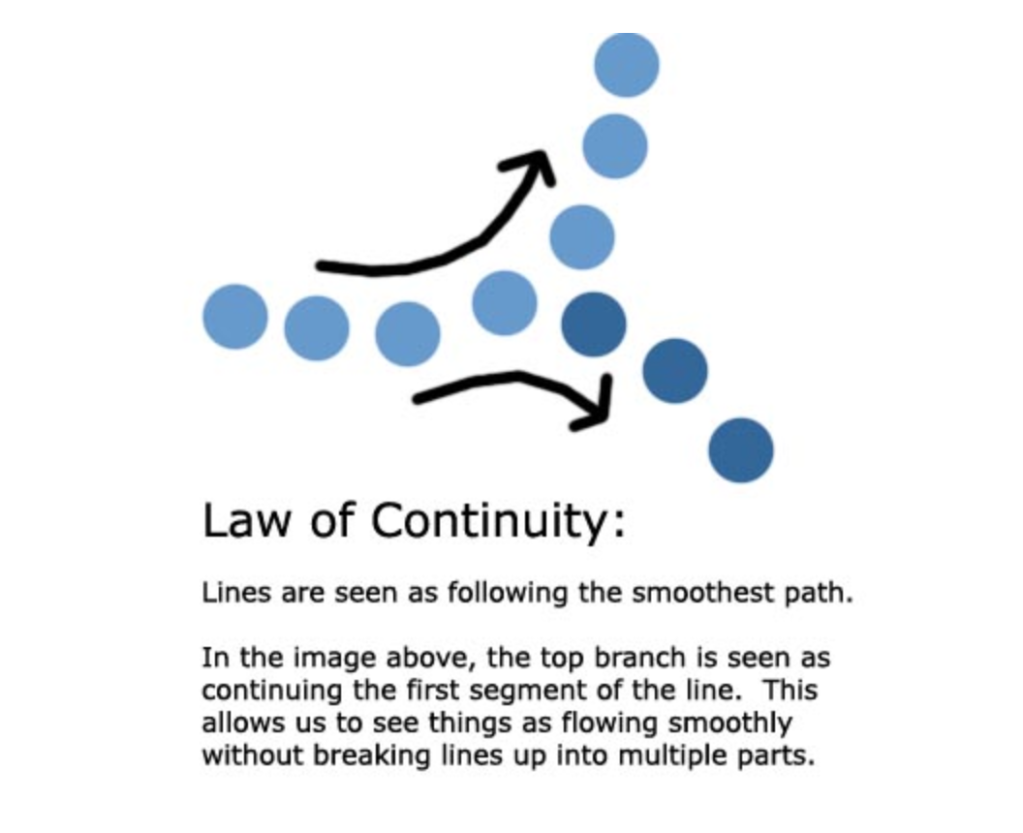Gestalt Psychology is a school of psychology that began in Austria and Germany in the early 20th Century. The work of Gestaltism was developed by Kurt Koffka, Wolfgang Köhler, and Max Wertheimer. The word is derived of the German language and is interpreted to mean “pattern” or “configuration.” Prof. Dejan Todorovic explains that Gestalt Principles are rules of organization of perceptual scenes, such as things in daily life or even within advertising. Todorovic explains that these principles formulate regularities according to which the perceptual input is organized. The principles mainly apply to vision but there are also such examples that take the form of auditory and somatosensory perceptions. The seven principles of Gestalt are Figure-Ground, Similarity, Proximity, Common Region, Continuity, Closure, and Focal Point.

The Law of Continuity
The Gestalt Principle of Continuity is described as a grouping method. “Oriented units of groups tend to be integrated into perceptual wholes if they are aligned with each other” (Todorovic). The Continuity Principle explains how our eyes are constantly searching for continuous patterns to follow. Psychologically speaking, our brains prefer to follow a smooth path and interpret things as a connected whole rather than a disconnected unit. Our brain tells our eyes to perceive things as continuous figures rather than being broken up into several smaller figures. For example, the image of a plus sign is perceived as two crossing lines rather than four lines meeting at a center point. Or a curved T shape with the labels shown AXBC. According to the Principle of Continuity, our eyes form the sub-whole of AXB along the top line of the T rather than AXC or BXC.
The Principle of Continuity is seen all throughout daily life and you might not even realize it. Take a simple three-step tutorial for example. Set side-by-side, we read the steps from left to right or labeled one, two, three. Think of it in terms of the continuation of something, our eyes follow the pattern even if something may appear to be broken up. The Coca-Cola logo for example is a commonly used example of the Law of Continuity. The C from “Cola” carries through the loop of the L in “Cola” and our eyes are still able to process that it reads “Cola” even though it appears as if it is broken up. Another popularly used example of continuity is the IBM logo. This can also be used as an example of proximity, but for reference to continuity, it appears as though all of the lines within the logo are broken apart; they are. But our mind still processes the continuation of the lines even through the apparent line breaks. We even see continuity in everyday ads featured within Amazon. When we make a purchase, the site shares with us other items that may be of interest to us. They give us a continuation of a variety of listed items that may be of interest to us based on our last purchase.
You may not even realize how much of our everyday life is filled with the Gestalt Principles. Our minds are very unique and brilliantly seek out patterns to help us to better process and understand things. Next time you are scrolling through websites, or out at the store, see if you are able to pick out any of these Gestalt Principles, I think you will be surprised at how often these Principles are used.
The post was researched and written by Morgan Glantz
The references used in this blog can be found here







I have always been very interested in psychology and enjoyed reading your blog and learning about the principle of continuity very much. Our brain works in amazing ways and it is so interesting to see just how the psychology of sight can relate to advertisement and the marketing of a brand. I think an image with continuity makes it more visually appealing, which is extremely important for creative advertisement and for the creation of logos. In fact, it is crucial that logo designers know all the visual Gestalt principles because they must understand how to make a design with visual meaning that can be easily interpreted by consumers (Paget, 2017). Without continuity in a logo, consumers would have trouble perceiving the image, which would take away the entire visual meaning and purpose of the logo. You did a great job explaining all of this!
LikeLiked by 1 person
For some reason, my reference link never attached. The resource I used for my response came from https://logogeek.uk/logo-design/gestalt-theory/
LikeLike
Please adjust the settings for your blog so that the comments automatically show.
LikeLike
This is a test http://www.drtmitchell.wordpress.com
LikeLike